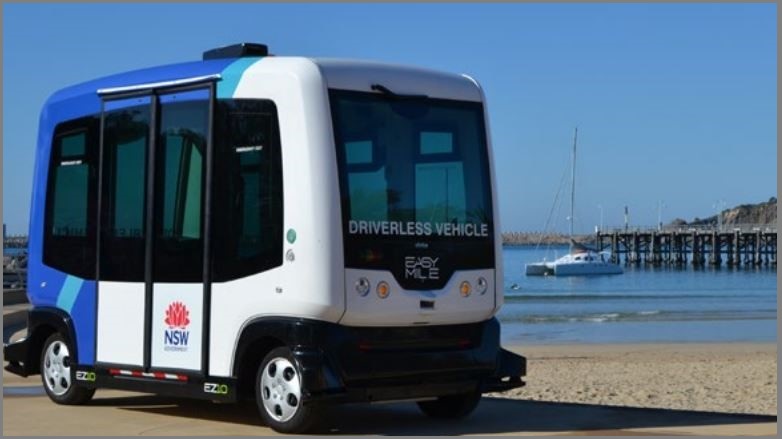New South Wales commuters may soon have access to a fleet of self-driving robotaxis, after state government agency Transport for NSW partnered with expanding ride-share firm Motional.
Announced this month, the partnership will see TfNSW and Motional undertake viability studies into a plan to launch driverless robotaxis within Australia.
Motional – a $5.5b ($US4b) joint venture of Korean industrial giant Hyundai Motor Group and US-based autonomous-vehicle interest Aptiv PLC – began operating last year with a remit to commercialise self-driving vehicle services.
It has since launched autonomous services in Singapore and several US cities, and recently announced plans to expand across Los Angeles – as well as ramping up its operations for a 2023 full commercial launch in numerous US cities.
Once the service is active, users of the Lyft ride-sharing app will be able to order a ride and be taken to their destination in driverless Hyundai-built IONIQ 5 robotaxis; early services included a standby human driver for safety.
There’s no word yet on whether the devices will include animatronic head and shoulders like Total Recall’s Johnny Cab, but the momentum towards their widespread rollout has enthused Australian authorities that have been closely watching autonomous vehicle services developing overseas.
“We need to start thinking about a number of factors such as locations and infrastructure, passenger demand, connections to public transport, and the benefits to local communities,” TfNSW deputy secretary customer strategy and technology Joost de Kock said in announcing the latest partnership.
“The partnership will help us better understand how a driverless ride share service could improve the NSW network by providing safer, more accessible, efficient, and affordable mobility options and understanding what needs to be adapted for Australian roads.”
Motional’s services are said to have carried over 100,000 rides with no at-fault incidents – a safety record that TfNSW emphasised as it works to establish a framework to replicate the services on Australian roads.
Motional conducts most R&D at an expansive site in the Las Vegas area and no plans for on-road testing in Australia have been announced yet.
TfNSW has, however, been testing the technologies at its Future Mobility Testing Centre, working with 150 partners of the Australia & New Zealand Driverless Vehicle Initiative (ADVI) at a 32-ha testing facility in rural Cudal, NSW that includes a 1.6km test track.
The agency has also been investing in data specialists, and last month announced a partnership with the University of Technology Sydney that will use AI to automatically rate the safety of the state’s roads.
This is a key data set that will inform decision-making about where autonomous vehicles are best deployed and what road upgrades are necessary – among the many focuses of the next National Road Safety Strategy, which authorities have said will address “emerging technologies including the increasing introduction of automated vehicles”.
Driving into an uncertain future
Based on the SAE scale – a widely-used categorisation of self-driving vehicles from Level 0 to Level 5 – the Motional and TfNSW services are Level 4 autonomous vehicles, which provide fully autonomous driving under a specific set of conditions.
Unlike earlier Level 3 systems – which require the presence of a human who is prepared to take over driving when instructed by the car – Level 4 vehicles may or may not even include pedals and a steering wheel.
This puts passengers completely at the mercy of the algorithms being tested and refined by Motional and well-funded competitors like Google cousin Waymo, GM-owned Cruise, Russian tech firm Yandex, and Chinese company Baidu.
Australia’s first driverless car trials debuted in 2015, while French company NAVYA announced plans for closed-road testing of robotaxies in Perth back in 2017.
It’s a long way from closed tests to fully roaming robotaxis, however – and for all the enthusiasm, self-driving vehicles have not been without their problems.
In August, Tokyo Olympic officials temporarily suspended the use of self-driving e-Palette ‘pods’ after a visually-impaired judo athlete was hit in the athlete’s village; authorities added a second operator to be tasked with scanning for pedestrians.
Despite tech firms’ enthusiasm for the model – and early support from places like the US state of Arizona – analysts have warned that the vision of ubiquitous robotaxis is uneconomical and may take many more years to deliver consumer-friendly self-driving cars in a commercially viable way.
Ride-sharing companies Uber and Lyft have already walked away from their own ventures, with Lyft – whose CEO famously claimed in 2016 that self-driving vehicles would “all but end” car ownership by 2025 – selling its Level 5 self-driving car operation to Toyota subsidiary Woven Planet.
The Toyota-backed Woven City venture has adopted autonomous vehicles as a core element, but that project is evolving within a highly constrained physical environment tailor-made for self-driving vehicles – and not simply unleashing the vehicles on the existing road system.
A previous AustRoads-backed project evaluated the safety benefits of cooperatives intelligent transport systems (ITS) – in which vehicles communicate with road markers and each other to increase safety – as well as autonomous systems, and noted that “despite the clear potential benefits, several limitations were found that will need to be addressed before widespread implementation becomes possible.”










